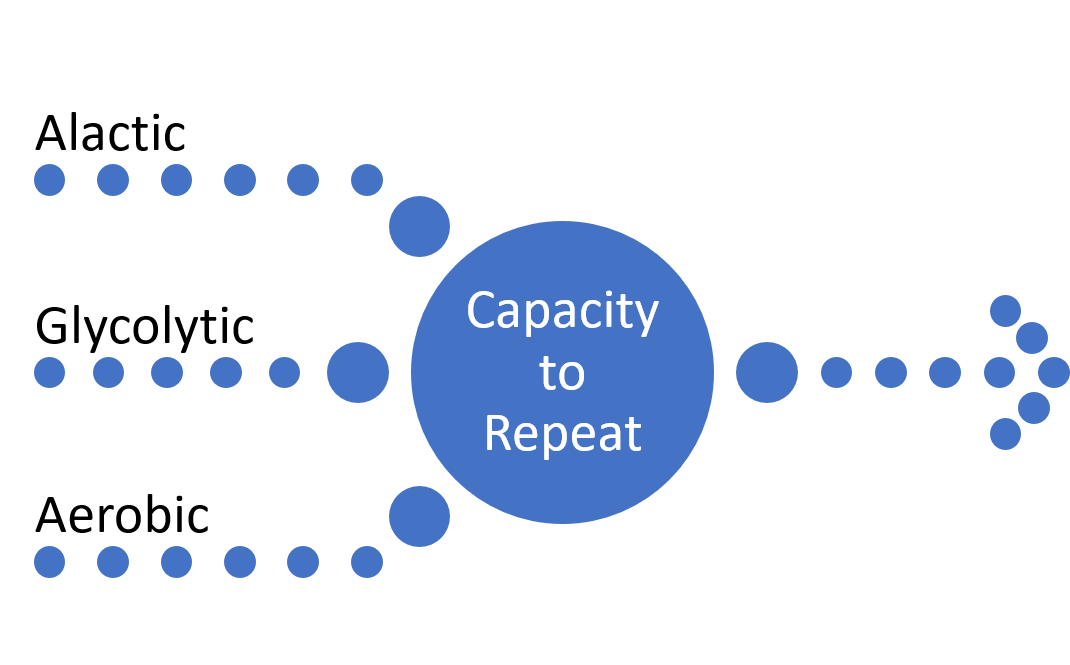Training guidelines for Repeated Sprint Ability or Repeated High Intensity Efforts
It may be tempting to think that to train RSA or RHIE effectively, then players should perform high intensity activities with low or incomplete rest in between bouts. This would generally lead coaches to target the glycolytic or lactic acid system predominantly during training. While the glycolytic system will certainly play a part in RSA and RHIE (especially during longer bouts of RHIE) it may not be the energy system that is best served prioritised. As already mentioned, the contribution of the glycolytic energy system decreases substantially as repeated efforts continue and it has also been suggested that subjects that show the greatest power decrement over multiple repeated sprints have the highest contribution from the glycolytic system in the first sprint. Instead of focusing on developing the glycolytic system with the training, the coach could train the ATP-PCR system and the aerobic system in an attempt to train the limiting factors of RSA.
Figure 10. In order to increase the player's capacity to repeat high intensity activities, it is important to train all three energy systems.

To improve Phosphocreatine resynthesis rate which has been identified as a key factor in RSA and RHIE, aerobic training is key, as the aerobic system is essential for replenishing Phosphocreatine. Therefore, higher level of aerobic fitness and a more efficient aerobic system can lead to improved Phosphocreatine resynthesis rates and the potential for improvements in RSA and RHIE. An improved aerobic system will also have many other benefits such as increased capillarisation, enhanced blood flow, and improved oxygen delivery to the working muscles, all of which can benefit performance and recovery between high intensity bouts. To improve aerobic fitness and VO2 max it appears that interval training working at or close to VO2 max is very effective. A sample training guideline to work on aerobic fitness with the aim of improving RSA or RHIE is as follows:
- 2 minutes at 80 - 100% VO2max
- 1-minute recovery period
- 6-12 sets per session.
The coach must also focus on training the ATP-PCr (Alactic) system. Alactic power and alactic capacity should be developed in training if the aim is to see an improvement in RSA and RHIE. Alactic power is the maximal power produced in short high intensity efforts and alactic capacity refers to the total amount of work done in a short high intensity effort. While the aerobic system development is helping the recovery between high intensity bouts, the alactic training is focusing on improving the performance in the high intensity bout itself. Alactic power training is short and sharp and usually requires complete rest in between efforts. An example of an alactic power session is as follows:
- 7-10 seconds per repetition
- Heart rate-based active recovery to 120bpm
- 5-6 repetitions per set
- 1-2 sets per session.
Alactic capacity sessions challenge the player to produce sustained high intensity efforts. An example of an alactic capacity session is as follows:
- 10-20 seconds per repetition
- 5-2 minutes rest between repetitions
- 4-6 repetitions per set.
It may seem strange that to train RSA a coach does not have to focus on performing repeated sprints, (alactic capacity work can look like repeated sprints depending on the protocol used). Repeated sprint protocols building up large amounts of lactic acid and working on the glycolytic system can still definitely be used in the training programme. It may be best to include this type of training closer to the start of the competition season in a 3-4 week block as the system does not have a great trainability so a short training focus may be enough to see benefits. The coach should focus on the physiological components of RSA that may produce the best performance and address the limiting factors to RSA performance. This will allow the player to optimally perform repeated sprints or repeated high intensity efforts when called upon in a game.